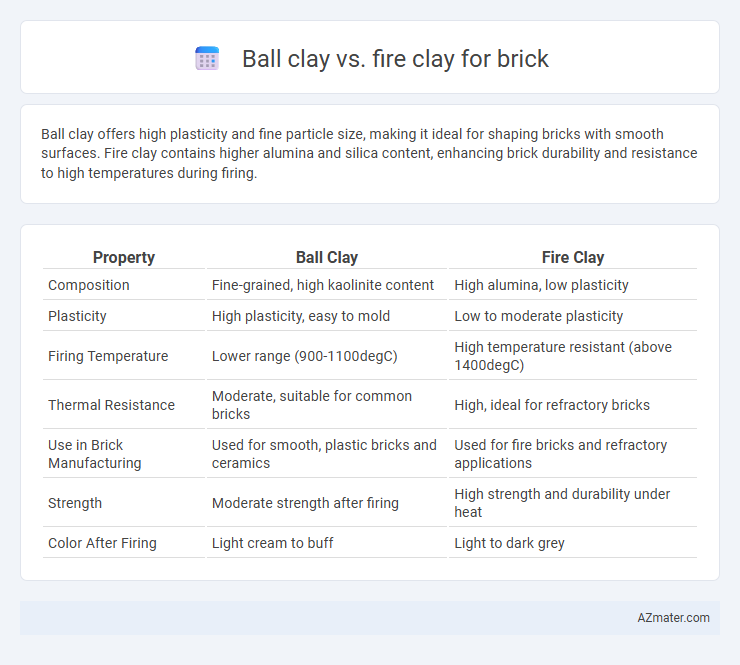Ball clay offers high plasticity and fine particle size, making it ideal for shaping bricks with smooth surfaces. Fire clay contains higher alumina and silica content, enhancing brick durability and resistance to high temperatures during firing.
Table of Comparison
| Property | Ball Clay | Fire Clay |
|---|---|---|
| Composition | Fine-grained, high kaolinite content | High alumina, low plasticity |
| Plasticity | High plasticity, easy to mold | Low to moderate plasticity |
| Firing Temperature | Lower range (900-1100degC) | High temperature resistant (above 1400degC) |
| Thermal Resistance | Moderate, suitable for common bricks | High, ideal for refractory bricks |
| Use in Brick Manufacturing | Used for smooth, plastic bricks and ceramics | Used for fire bricks and refractory applications |
| Strength | Moderate strength after firing | High strength and durability under heat |
| Color After Firing | Light cream to buff | Light to dark grey |
Introduction to Ball Clay and Fire Clay
Ball clay and fire clay are essential raw materials in brick manufacturing, each contributing distinct properties to the final product. Ball clay is a fine-grained, highly plastic sedimentary clay containing kaolinite, mica, and quartz, prized for its excellent plasticity and binding properties that improve brick malleability and surface smoothness. Fire clay, composed mainly of hydrous aluminum silicates, is highly refractory, withstanding high temperatures and providing structural strength and heat resistance to bricks used in high-temperature environments such as kilns and furnaces.
Chemical Composition Differences
Ball clay contains higher amounts of kaolinite, mica, and quartz with significant levels of organic matter and carbonates, leading to high plasticity and fine particle size, while fire clay is richer in alumina (Al2O3) and silica (SiO2) but lower in organic content, providing higher refractory properties and heat resistance. The chemical composition of ball clay includes approximately 45-55% silica and 20-30% alumina, whereas fire clay typically has 35-50% silica and 30-40% alumina, influencing their suitability for different brick manufacturing processes. Variations in trace elements like iron oxide in ball clay can affect coloration, whereas fire clay's purity supports its use in high-temperature applications such as firebrick production.
Physical Properties Comparison
Ball clay exhibits higher plasticity and finer particle size compared to fire clay, making it ideal for shaping and molding bricks with smooth surfaces. Fire clay possesses greater refractory strength and thermal stability, allowing bricks to withstand higher firing temperatures and thermal shock resistance. The density of ball clay is typically lower than fire clay, influencing the final brick's hardness and durability.
Suitability for Brick Manufacturing
Ball clay exhibits high plasticity and fine particle size, making it ideal for shaping and forming bricks with smooth surfaces and uniform texture. Fire clay offers superior refractory properties and withstands high temperatures, beneficial for bricks used in kilns or high-heat environments. For general brick manufacturing, ball clay enhances workability and strength, while fire clay is preferred for heat-resistant bricks.
Workability and Plasticity
Ball clay exhibits higher plasticity and superior workability compared to fire clay, making it ideal for shaping and molding bricks with intricate details. Fire clay has lower plasticity, resulting in reduced flexibility during forming but offers higher refractory properties suited for high-temperature applications. The enhanced plasticity of ball clay improves the uniformity and strength of bricks, while fire clay's composition provides durability and resistance to thermal stress.
Firing Temperature Requirements
Ball clay requires a relatively lower firing temperature, typically ranging from 1000degC to 1150degC, making it suitable for bricks that need moderate strength and smooth texture. Fire clay demands higher firing temperatures, generally between 1200degC and 1400degC, providing excellent heat resistance and increased durability essential for refractory bricks. Choosing the right clay depends on the brick's intended use, with ball clay favored for general-purpose bricks and fire clay preferred for high-temperature applications.
Color and Finish Outcomes
Ball clay imparts a creamy, smooth texture to bricks, resulting in a lighter, more uniform color ideal for decorative finishes. Fire clay produces bricks with a reddish to brown hue, offering enhanced durability and a rougher surface texture suitable for structural applications. Color and finish outcomes vary significantly between the two, with ball clay favored for aesthetic appeal and fire clay preferred for heat resistance and strength.
Strength and Durability in Bricks
Ball clay offers high plasticity and fine particle size, resulting in bricks with smooth textures but lower strength and durability compared to fire clay. Fire clay, rich in alumina and silica, withstands high firing temperatures, producing bricks with superior compressive strength and excellent resistance to weathering and thermal shock. The enhanced density and refractory properties of fire clay make it the preferred choice for durable, high-strength bricks in construction projects requiring long-lasting performance.
Cost Considerations and Availability
Ball clay is generally more expensive than fire clay due to its higher plasticity and finer particle size, which enhances brick quality but increases raw material costs. Fire clay is more abundant and widely available, often sourced from local deposits, making it a cost-effective option for large-scale brick production. Choosing between ball clay and fire clay depends on balancing material performance with budget constraints and regional supply availability.
Choosing the Right Clay for Your Brick Project
Ball clay offers excellent plasticity and smooth texture, making it ideal for intricate brick designs requiring fine detail and flexibility during shaping. Fire clay, with its high alumina and silica content, provides superior heat resistance and durability, perfect for bricks exposed to high temperatures such as in fireplaces or industrial applications. Selecting the right clay depends on your project's need for aesthetic precision and thermal performance, balancing workability with structural resilience.

Infographic: Ball clay vs Fire clay for Brick
 azmater.com
azmater.com